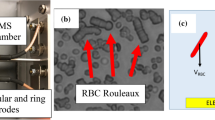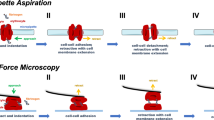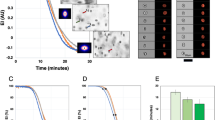Abstract
The mechanism by which cell suspensions are agglutinated by plant lectins remains obscure. The agglutination of a particular cell line in the presence of a specific plant lectin probably depends on several factors including the number and valence of lectin molecules bound to the cell surface, the mobility of receptor molecules in the membrane, the surface morphology and charge and the metabolic state of the cell1–6. The assay system used to assess cell agglutination also seems to be important, since many laboratories studying the same agglutination reaction have reported dissimilar or contradictory results3,4,7. To provide further information on the molecular mechanism of agglutination we have begun a systematic study on the aggregation of human red cells by the lectin concanavalin A (Con A). By using an adaptation of our previously described aggregation assay8 which provides a continuous measure of both the rate and degree of intercellular adhesion in the presence of controlled shear forces, we have found that the agglutination of erythrocytes by Con A can be resolved into three stages, two of which are observed only if the system is exposed to shear.
This is a preview of subscription content, access via your institution
Access options
Subscribe to this journal
Receive 51 print issues and online access
$199.00 per year
only $3.90 per issue
Buy this article
- Purchase on Springer Link
- Instant access to full article PDF
Prices may be subject to local taxes which are calculated during checkout
Similar content being viewed by others
References
Nicolson, G. L. Int. Rev. Cytol. 39, 89–190 (1974).
Haskovec, C. & Kinkor, M. Fol. biol. (Praha) 22, 225–234 (1976).
Singer, J. A. & Morrison, M. Biochim. biophys. Acta 426, 123–131 (1976).
Schnebli, H. P. & Bachi, T. Expl Cell Res. 91, 175–183 (1975).
Schnebli, H. P., Roeder, C. & Tarcsay, L. Expl Cell Res. 98, 273–276 (1976).
Willingham, M. C. & Pastan, I. Proc. natn. Acad. Sci. U.S.A. 72, 1263–1267 (1975).
Vlodavsky, I., Inbar, M. & Sachs, L. Biochim. biophys. Acta 274, 364–369 (1972).
Brooks, D. E., Goodwin, J. W. & Seaman, G. V. F. Biorheology 11, 69–77 (1974).
Narasimhan, S., Wilson, J. R., Martin, E. & Schachter, H. Can. J. Biochem. 57, 83–96 (1979).
Baenziger, J. U. & Fiele, D. J. biol. Chem. 254, 2400–2407 (1979).
Williams, T. J., Shafer, J. A. & Goldstein, I. J. J. biol. Chem. 253, 8533–8537 (1978).
Ochoa, J. L., Kristiansen, T. & Pahlam, S. Biochim. biophys. Acta 577, 102–109 (1979).
Edelman, G. M. & Wang, J. L. J. biol. Chem. 253, 3016–3022 (1978).
Nakamura, J. & Terayama, H. Proc. natn. Acad. Sci. U.S.A. 72, 498–502 (1975).
Phillips, P. G. & Furmanski, P. in Concanvalin A as a Tool (eds Bittiger, H. & Schnebli, H. P.) 181–186 (Wiley, New York, 1976).
Gordon, J. A. & Young, R. K. J. biol. Chem. 254, 1932–1937 (1979).
Author information
Authors and Affiliations
Rights and permissions
About this article
Cite this article
Greig, R., Brooks, D. Shear-induced concanavalin A agglutination of human erythrocytes. Nature 282, 738–739 (1979). https://doi.org/10.1038/282738a0
Received:
Accepted:
Issue Date:
DOI: https://doi.org/10.1038/282738a0
This article is cited by
-
Contact patterns in concanavalin A agglutinated erythrocytes
Cell Biophysics (1991)
-
Spreading of wheat germ agglutinin-induced erythrocyte contact by formation of spatially discrete contacts
Cell Biophysics (1990)
-
Membrane-Membrane contact: Involvement of interfacial instability in the generation of discrete contacts
Bioscience Reports (1989)
-
Experimental systems for analysis of the malignant phenotype
Cancer and Metastasis Review (1982)
-
Physiological shear stresses enhance the Ca2+ permeability of human erythrocytes
Nature (1981)
Comments
By submitting a comment you agree to abide by our Terms and Community Guidelines. If you find something abusive or that does not comply with our terms or guidelines please flag it as inappropriate.



